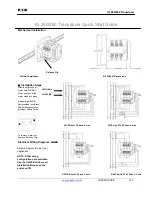
Page 44
O
PERATING
M
ANUAL
D
EALING
WITH
I
NTERFERENCE
O
PERATION
The
MARK-V FT-1000MP
Field
includes a wide
range of special features to suppress the many types
of interference that may be encountered on the HF
bands. However, real world interference conditions are
constantly changing, so optimum setting of the con-
trols is somewhat of an art, requiring familiarity with
the types of interference and the subtle effects of some
of the controls. Therefore, the following information is
provided as general guidelines for typical situations,
and a starting point for your own experimentation.
The
MARK-V FT-1000MP
Field
’s interference-fight-
ing circuitry begins in its “RF” stages, and continues
throughout the entire receiver section.
VRF (V
ARIABLE
RF F
RONT
-
END
F
ILTER
)
The
VRF
feature allows you to engage a narrow
band-pass “preselector” filter into the receiver’s RF cir-
cuit path. The added selectivity can be a tremendous
help in minimizing potential interference from strong
out-of-band signals, especially in a multi-transmitter
operating environment.
To activate the VRF feature, press
the [
VRF
] button on the
Shuttle Jog
,
then turn the
VRF/MEM CH
knob to
peak the signal or background noise
level. When the
VRF
feature is en-
gaged, the red “
VRF
” LED, located on
the left side of the
VRF/MEM CH
knob, will be illumi-
nated.
If a potentially-interfering signal is very near your cur-
rent operating frequency (for example, an SSB station
operating near 3.80 MHz while you are on 3.52 MHz),
additional protection may be realized by deliberately mis-
tuning the VRF so as to place more “roll-off” of the
undesired signal. In this example, tuning the VRF for
peak response at 3.40 MHz will cause additional at-
tenuation to be placed on the strong signal at 3.80 MHz.
Particularly on the lower frequency bands, there will be
no loss of useful sensitivity with moderate de-tuning,
but interference rejection will be significantly enhanced.
F
RONT
E
ND
S
ELECTIONS
:
A
MP
S
ELECTION
, IPO & ATT
The best receiver front-end selection will depend
on background noise at the time, the presence or ab-
sence of strong signals, and whether or not you want
to hear very weak signals. If the front end is set for too
much gain, background noise will make listening diffi-
cult, and very strong signals on other frequencies may
cause intermodulation interference, masking weaker
signals. On the other hand, if the front end is set for
too little gain (or too much attenuation), very weak sig-
nals will not be heard.
When evaluating the selections below, remember
that if you can hear band noise increase when your
antenna is connected, you have adequate sensitivity;
any further early-stage gain is not needed.
“Wide Band” and “Tuned” Preamp
Selection
Three high-performance FET RF amplifiers are uti-
lized in the
MARK-V FT-1000MP
Field
receiver front
end. A single wide-band amp is provided for good gen-
eral all-around performance, along with dual tuned
amplifiers: one optimized for 24~30 MHz, the other for
1.8~7 MHz (see illustration). The Tuned preamp is es-
pecially useful when operating from a quiet location on
10 meters, while on the low bands the Tuned preamp’s
low gain provides optimum strong-signal performance.
Each amplifier is selected automatically as you tune or
change bands; however, you can disable the tuned
amplifier pair and only use the wide-band amp via
menu
selection 8-4
.
Note that the Tuned preamp only operates in the
1.8~7 and 24~30 amateur bands. If you tune outside
of an amateur band while using the Tuned preamp,
the transceiver will automatically switch over to the “Flat”
(Wide-band) preamp. The effects of this design are:
(1) When tuning outside of a low-frequency amateur
Receiver Front End Configuration
(for illustrative purposes)
22-30 MHz
10-12 MHz
12-15 MHz
6.5-8 MHz
3-4 MHz
0.5-1.8 MHz
0.1-0.5 MHz
15-22 MHz
8-10 MHz
4-6.5 MHz
1.8-3 MHz
Bandpass Filter Section
RF Amp Section
Menu Section 8-4
A
Antenna
B
VRF/MEM CH
DWN
UP
A/B
ANT
RX
0
6
12
18
dB
( )
ATT
6 dB
0.1-30 MHz
Wide
Band
High
Band
Low
Band
24-30 MHz
1.9-7 MHz
0 dB (Through)
TUN
ON
FLAT
OFF
12 dB
18 dB
IPO
Tuned RF Amp Section
Note:
VRF only functions
on the 160-20 M
Amateur bands.
Summary of Contents for MARK-V FT-100MP
Page 119: ......
















































